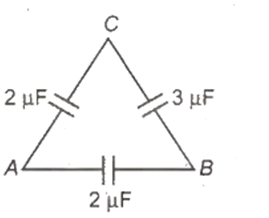 Multiple Choice Questions
Multiple Choice QuestionsChoose the wrong statement about equipotential surfaces.
It is a surface over which the potential is constant
The electric field is parallel to the equipotential surface
The electric field is perpendicular to the equipotential surface
The electric field is in the direction of steepest decrease of potential
Three capacitors connected in series have an effective capacitance of 4 µF. If one of the capacitance is removed, the net capacitance of the capacitor increases to 6 µF. The removed capacitor has a capacitance of
2 µF
4 µF
10 µF
12 µF
The electric potential V at any point (x, y, z) in space is given by V = 3x2 where x, y, z are all in metre. The electric field at the point (1 m, 0, 2 m) is
6 V m-1 along negative x-axis
6 V m-1 along positive x-axis
12 V m-1 along negative x-axis
12 V m-1 along positive x-axis
Two equal point charges each of 3 µC are separated by a certain distance in metres. If they are located at (i + j + k)and (2i + 3j + k), then the electrostatic force between them is
9 × 103 N
9 × 10-3 N
16.5 × 10-3 N
3 × 10-3 N
Two resistors of resistances 200 kΩ and 1 MΩ respectively form a potential divider with outer junctions maintained at potentials of+ 3 V and −15 V. Then, the potential at the junction between the resistors is
+ 1 V
− 0.6 V
Zero
− 12 V
C.
Zero

Three capacitors are connected in the arms of a triangle ABC as shown in figure. 5 V is applied between A and B. The voltage between B and C is

2 V
1 V
3 V
1.5 V
Two point charges + 5 µC and − 2 µC are kept at a distance of 1 m in free space. The distance between the two zero potential points on the line joining the charges is
C,V,U and Q are capacitance, potential difference, energy stored and charge of a parallel plate capacitor respectively. The quantities that increase when a dielectric slab is introduced between the plates without disconnecting the battery are
V and C
V and U
U and Q
V and Q
A capacitor of capacitance value 1 µF is charged to 30 V and the battery is then disconnected. If the remaining circuit is connected across a 2 µF capacitor, the energy lost by the system is
300 µJ
450 µJ
225 µJ
150 µJ
Three charges Q0, -q and -q are placed at the vertices of an isosceles right angle triangle as in the figure. The net electrostatic potential energy is zero if Q0 is equal to

+ q
